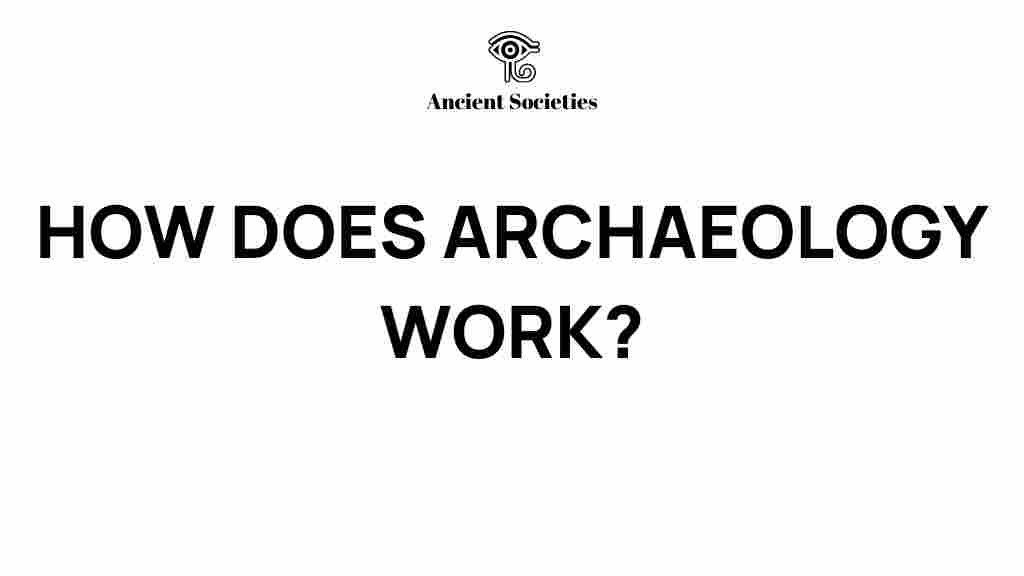Unveiling the Secrets: How Archaeology Transforms Our Understanding
Archaeology is a fascinating field that bridges the past and present, offering insights into ancient civilizations and their cultural heritage. Through systematic excavation and the study of historical artifacts, archaeologists unlock the mysteries of bygone eras, enriching our understanding of human history. This article will explore how archaeology transforms our perception of the past, the methods used in fieldwork, and the interdisciplinary approaches that enhance archaeological research.
The Importance of Archaeology
Archaeology serves as a vital tool for understanding the complexities of ancient societies. By examining the remnants of past cultures, we can gain a clearer view of human development, social structures, and technological advancements. The significance of archaeology can be summarized in the following points:
- Preservation of Cultural Heritage: Archaeology helps preserve the remnants of ancient civilizations, ensuring that future generations can learn from them.
- Understanding Historical Context: It provides context for historical events, offering a more comprehensive view of how societies interacted and evolved.
- Research Methods: Employing various research methods, archaeology combines techniques from the sciences and humanities to analyze artifacts and sites.
Excavation: The Heart of Archaeological Research
Excavation is a fundamental aspect of archaeology that involves systematically uncovering artifacts and features from the ground. This process is meticulous and requires careful planning and execution. Here’s a step-by-step process of how excavation is typically conducted:
Step 1: Site Selection
Choosing an appropriate site for excavation is crucial. Archaeologists often rely on historical records, surveys, and even satellite imagery to identify potential areas rich in artifacts.
Step 2: Surveying the Area
Once a site is selected, archaeologists conduct a thorough survey. This may involve:
- Ground-penetrating radar to detect subsurface features.
- Surface collection of artifacts to gauge the site’s potential.
- Mapping the area using GPS technology.
Step 3: Digging and Documentation
During excavation, archaeologists dig in controlled layers to preserve stratigraphy, which helps in understanding the chronological sequence of the site. Proper documentation is essential, including:
- Recording the exact location of each artifact.
- Photographing the excavation process.
- Keeping detailed notes on findings and contexts.
Step 4: Analysis of Artifacts
After excavation, the next phase involves analyzing the recovered artifacts. This can include:
- Dating methods such as radiocarbon dating or dendrochronology.
- Material analysis to determine the composition and origin of artifacts.
- Contextual analysis to understand the use and significance of artifacts within the culture.
Interdisciplinary Studies in Archaeology
Archaeology does not exist in isolation; it intersects with various disciplines, enhancing our understanding of ancient civilizations. Some key interdisciplinary fields include:
- History: Provides written records that can complement archaeological findings.
- Anthropology: Offers insights into cultural practices and human behavior.
- Geology: Helps in understanding the natural landscape and its influence on human settlement.
- Botany and Zoology: Aid in studying ancient diets and ecosystems.
Challenges in Archaeological Excavation
While excavation can yield remarkable discoveries, it also presents several challenges. Here are some common issues faced by archaeologists:
1. Environmental Factors
Weather conditions, soil composition, and environmental degradation can affect excavation efforts. Archaeologists must adapt their strategies to cope with these challenges.
2. Legal and Ethical Considerations
Excavation often involves navigating complex legal frameworks related to land ownership and cultural heritage preservation. Ethical considerations are paramount to avoid the looting and exploitation of sites.
3. Funding and Resource Constraints
Securing funding for archaeological projects can be difficult. Many excavations rely on grants, donations, or academic support, which can limit the scope of research.
Preservation of Historical Artifacts
Preserving historical artifacts is essential for future research and education. Proper conservation techniques include:
- Stabilizing artifacts to prevent deterioration.
- Storing items in controlled environments to protect them from moisture and temperature changes.
- Engaging in digital preservation, such as 3D scanning, to create virtual records of artifacts.
Research Methods in Archaeology
Archaeologists employ a variety of research methods to gather data and draw conclusions. Some commonly used methods include:
1. Stratigraphy
This involves studying the layers of soil and artifacts to establish a timeline for human activity at a site.
2. Typology
Artifacts are classified based on their characteristics and functions, helping archaeologists understand cultural and chronological relationships.
3. Ethnoarchaeology
This method examines contemporary cultures to draw parallels with ancient practices, providing insights into how societies functioned.
Fieldwork: The Archaeologist’s Experience
Fieldwork is a critical component of archaeological practice. It allows researchers to directly engage with the past and experience the thrill of discovery. Here are some key aspects of fieldwork:
1. Team Collaboration
Excavation often involves a diverse team of specialists, including archaeologists, conservators, and historians. Collaboration enhances the research output and promotes knowledge sharing.
2. Community Involvement
Engaging local communities in archaeological projects fosters a sense of ownership and pride in cultural heritage. It also aids in the preservation of sites and artifacts.
3. Ongoing Education
Fieldwork provides hands-on experience for students and volunteers, contributing to the next generation of archaeologists. Workshops and training sessions are often held to educate participants about excavation techniques and research methods.
Conclusion: The Future of Archaeology
As technology advances, the field of archaeology continues to evolve. Innovations such as remote sensing, GIS mapping, and advanced analytical techniques are revolutionizing how archaeologists conduct research and preserve artifacts. The secrets unveiled through archaeological excavation not only enhance our understanding of ancient civilizations but also foster a greater appreciation for cultural heritage.
By embracing interdisciplinary studies and addressing the challenges of the field, archaeologists are better equipped to protect and interpret the historical treasures that connect us to our past. The journey of discovery is ongoing, and each excavation holds the promise of new revelations about humanity’s shared history.
For more information on archaeological methods and practices, visit this resource. To learn about ongoing archaeological projects, you can check out this link.
This article is in the category Archaeology and created by AncientSocieties Team
